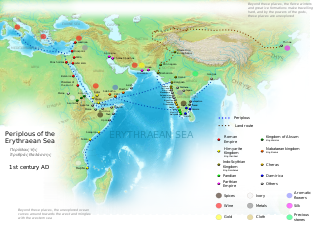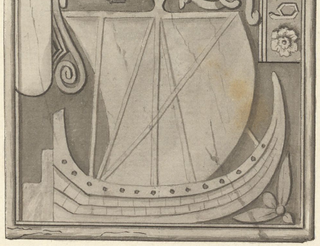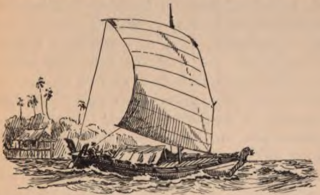
A ship is a large watercraft that travels the world's oceans and other sufficiently deep waterways, carrying cargo or passengers, or in support of specialized missions, such as defense, research and fishing. Ships are generally distinguished from boats, based on size, shape, load capacity and purpose. Ships have supported exploration, trade, warfare, migration, colonization, and science. Ship transport is responsible for the largest portion of world commerce.

A fishing trawler is a commercial fishing vessel designed to operate fishing trawls. Trawling is a method of fishing that involves actively dragging or pulling a trawl through the water behind one or more trawlers. Trawls are fishing nets that are pulled along the bottom of the sea or in midwater at a specified depth. A trawler may also operate two or more trawl nets simultaneously.

A cargo ship or freighter is a merchant ship that carries cargo, goods, and materials from one port to another. Thousands of cargo carriers ply the world's seas and oceans each year, handling the bulk of international trade. Cargo ships are usually specially designed for the task, often being equipped with cranes and other mechanisms to load and unload, and come in all sizes. Today, they are almost always built of welded steel, and with some exceptions generally have a life expectancy of 25 to 30 years before being scrapped.
Aromata, also called the Spice Port, was an emporium and seaport in the Horn of Africa, today a part of Somalia. It lay near the tip of Cape Guardafui, which was itself called the "promontory of spices". It was notable for its produce of resins and various herbs.

Hafun is a town in the northeastern Bari province of Somalia. Situated in Ras Hafun on the coast of the Guardafui Channel, it is the centre of the Hafun District, and the easternmost town in continental Africa. It is an ancient town previously known as Opone.

Ras Hafun, also known as Cape Hafun, is a promontory in the northeastern Bari region of Somalia. Jutting out into the Guardafui Channel, it constitutes the easternmost point in Africa. The area is situated near the Cape Guardafui headland. It is joined to the mainland at the town of Foar, by a sand spit 20.0 km (12.4 mi) long, 1.0–3.0 km (0.62–1.86 mi) in width, and 5.0 m (16.4 ft) above sea level. The fishing town of Hafun is located on the promontory, 2.0 km (1.2 mi) east of the sand spit.

Opone was an ancient proto-Somali city situated in the Horn of Africa. It is primarily known for its trade with the Ancient Egyptians, Romans, Greeks, Persians, and the states of ancient India. Through archaeological remains, the historic port has been identified with the city of Hafun on the Hafun peninsula in modern-day Northeast Somalia. It is possible that it corresponds to the Land of Punt as known by the ancient Egyptians during the Old, Middle, and New Kingdom.

Bayla, is a coastal town along the Guardafui Channel in the northeastern Bari region of Somalia. It is the capital of the Bayla District.

The birlinn or West Highland galley was a wooden vessel propelled by sail and oar, used extensively in the Hebrides and West Highlands of Scotland from the Middle Ages on. Variants of the name in English and Lowland Scots include "berlin" and "birling". The Gaelic term may derive from the Norse byrðingr, a type of cargo vessel. It has been suggested that a local design lineage might also be traceable to vessels similar to the Broighter-type boat, equipped with oars and a square sail, without the need to assume a specific Viking design influence. It is uncertain, however, whether the Broighter model represents a wooden vessel or a skin-covered boat of the currach type. The majority of scholars emphasise the Viking influence on the birlinn.
The ships of Medieval Europe were powered by sail, oar, or both. There was a large variety, mostly based on much older, conservative designs. Although wider and more frequent communications within Europe meant exposure to a variety of improvements, experimental failures were costly and rarely attempted. Ships in the north were influenced by Viking vessels, while those in the south by classical or Roman vessels. However, there was technological change. The different traditions used different construction methods; clinker in the north, carvel in the south. By the end of the period, carvel construction would come to dominate the building of large ships. The period would also see a shift from the steering oar or side rudder to the stern rudder and the development from single-masted to multi-masted ships. As the area is connected by water, people in the Mediterranean built different kinds of ships to accommodate different sea levels and climates. Within the Mediterranean area during the Medieval times ships were used for a multitude of reasons, like war, trade, and exploration.

A fishing vessel is a boat or ship used to catch fish in the sea, or on a lake or river. Many different kinds of vessels are used in commercial, artisanal and recreational fishing.

Boitas were larger boats and ships that were built in the ancient Kalinga region during its maritime history. Kalinga's sea facing regions consisting of coastal Odisha had major trading ports for which boitas were used. Ancient Sadhabas sailed from Kalinga to distant lands such of Sri Lanka and South-East Asia including both mainland and insular Southeast Asian regions for trade.
Piracy off the coast of Somalia occurs in the Gulf of Aden, Guardafui Channel, and Somali Sea, in Somali territorial waters and other surrounding places and has a long and troubled history with different perspectives from different communities. It was initially a threat to international fishing vessels during the early 2000s, only to rapidly escalate and expand to international shipping during the War in Somalia (2006–2009).

El Ayo, also known as El Ayum, is a coastal town in the eastern Sanaag region of Somalia, near the border with Somalia. There is a base of the Puntland Maritime Police Force, which is effectively controlled by Puntland.
Wargaade Wall is an ancient stone construction in Wargaade, Somalia. It enclosed a large historic settlement in the region.

Maritime history of Somalia refers to the seafaring tradition of the Somali people. It includes various stages of Somali navigational technology, shipbuilding and design, as well as the history of the Somali port cities. It also covers the historical sea routes taken by Somali sailors which sustained the commercial enterprises of the historical Somali kingdoms and empires, in addition to the contemporary maritime culture of Somalia.
Damo is an ancient proto-Somali town in northeastern Somalia. It is situated in the autonomous Puntland region, 5 km west of Cape Guardafui.

Maritime archaeology in East Africa spans the range from the horn of Somalia south to Mozambique, and includes the various islands and island chains dotting the map off the coast of Somalia, Mozambique, Tanzania and Kenya. Primary areas along this coast include the Zanzibar, Lamu, and Kilwa Archipelagos. Although East African societies developed nautical capabilities for themselves, most of the maritime artifacts point to external merchants from Mediterranean cultures like Egypt and Greece, Indian and Chinese from South and East Asia in the early stages, to the great European powers during the Ages of Colonization and Imperialism.

Perahu Mayang or simply mayang is a type of fishing boat from Java, Indonesia. This type of boat is used mainly for fishing and trading. Historically, this indigenous vessel is also favored by European skippers and private merchants for trading in East Indies: 50% of them were using mayang and pencalang. It is mostly used in northern coast of Java. The major production site is in Rembang, Central Java.

A kakap is a narrow river or coastal boat used for fishing in Malaysia, Indonesia, and Brunei. They are also sometimes used as auxiliary vessels to larger warships for piracy and coastal raids.















